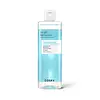What's inside
What's inside
 Key Ingredients
Key Ingredients

 Benefits
Benefits

 Concerns
Concerns

No concerns
 Ingredients Side-by-side
Ingredients Side-by-side

Water
Skin ConditioningIsododecane
EmollientIsohexadecane
EmollientGlycerin
HumectantC12-15 Alkyl Benzoate
AntimicrobialIsopropyl Palmitate
EmollientPropylene Glycol
HumectantPropanediol
SolventSodium Chloride
MaskingRosa Damascena Flower Water
MaskingPhenoxyethanol
PreservativePolyaminopropyl Biguanide
PreservativeEthylhexylglycerin
Skin ConditioningZinc Hydrolyzed Hyaluronate
HumectantSodium Hyaluronate
HumectantDextrin
AbsorbentDisodium Phosphate
BufferingPotassium Phosphate
BufferingProtease
ExfoliatingLipase
Skin ConditioningBifida Ferment Lysate
Skin ConditioningPhospholipids
Skin ConditioningPhenethyl Alcohol
MaskingLactose
HumectantMilk Protein
Skin ConditioningPotassium Sorbate
PreservativeSphingolipids
EmollientSodium Citrate
BufferingWater, Isododecane, Isohexadecane, Glycerin, C12-15 Alkyl Benzoate, Isopropyl Palmitate, Propylene Glycol, Propanediol, Sodium Chloride, Rosa Damascena Flower Water, Phenoxyethanol, Polyaminopropyl Biguanide, Ethylhexylglycerin, Zinc Hydrolyzed Hyaluronate, Sodium Hyaluronate, Dextrin, Disodium Phosphate, Potassium Phosphate, Protease, Lipase, Bifida Ferment Lysate, Phospholipids, Phenethyl Alcohol, Lactose, Milk Protein, Potassium Sorbate, Sphingolipids, Sodium Citrate
 Reviews
Reviews

Ingredients Explained
These ingredients are found in both products.
Ingredients higher up in an ingredient list are typically present in a larger amount.
Ethylhexylglycerin (we can't pronounce this either) is commonly used as a preservative and skin softener. It is derived from glyceryl.
You might see Ethylhexylglycerin often paired with other preservatives such as phenoxyethanol. Ethylhexylglycerin has been found to increase the effectiveness of these other preservatives.
Propanediol is an all-star ingredient. It softens, hydrates, and smooths the skin.
It’s often used to:
Propanediol is not likely to cause sensitivity and considered safe to use. It is derived from corn or petroleum with a clear color and no scent.
Learn more about PropanediolSodium Citrate is the sodium salts of citric acid. In skincare, it is used to alter pH levels and acts as a preservative.
Its main functions are to maintain the pH of a product and neutralize metal ions.
The acidity of our skin is maintained by our glands and skin biome; normal pH level of skin is slightly acidic (~4.75-5.5).
Being slightly acidic allows our skin to create an "acid mantle". This acid mantle is a thin barrier that protects our skin from bacteria and contaminants.
Learn more about Sodium CitrateSodium Hyaluronate is hyaluronic acid's salt form. It is commonly derived from the sodium salt of hyaluronic acid.
Like hyaluronic acid, it is great at holding water and acts as a humectant. This makes it a great skin hydrating ingredient.
Sodium Hyaluronate is naturally occurring in our bodies and is mostly found in eye fluid and joints.
These are some other common types of Hyaluronic Acid:
Learn more about Sodium HyaluronateWater. It's the most common cosmetic ingredient of all. You'll usually see it at the top of ingredient lists, meaning that it makes up the largest part of the product.
So why is it so popular? Water most often acts as a solvent - this means that it helps dissolve other ingredients into the formulation.
You'll also recognize water as that liquid we all need to stay alive. If you see this, drink a glass of water. Stay hydrated!
Learn more about Water